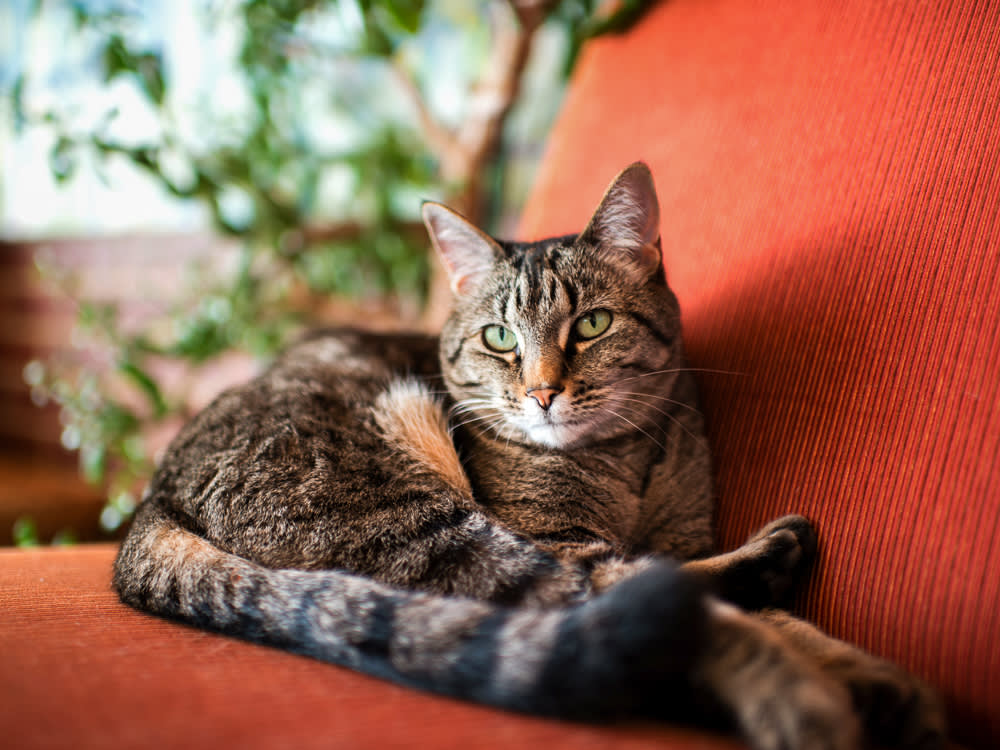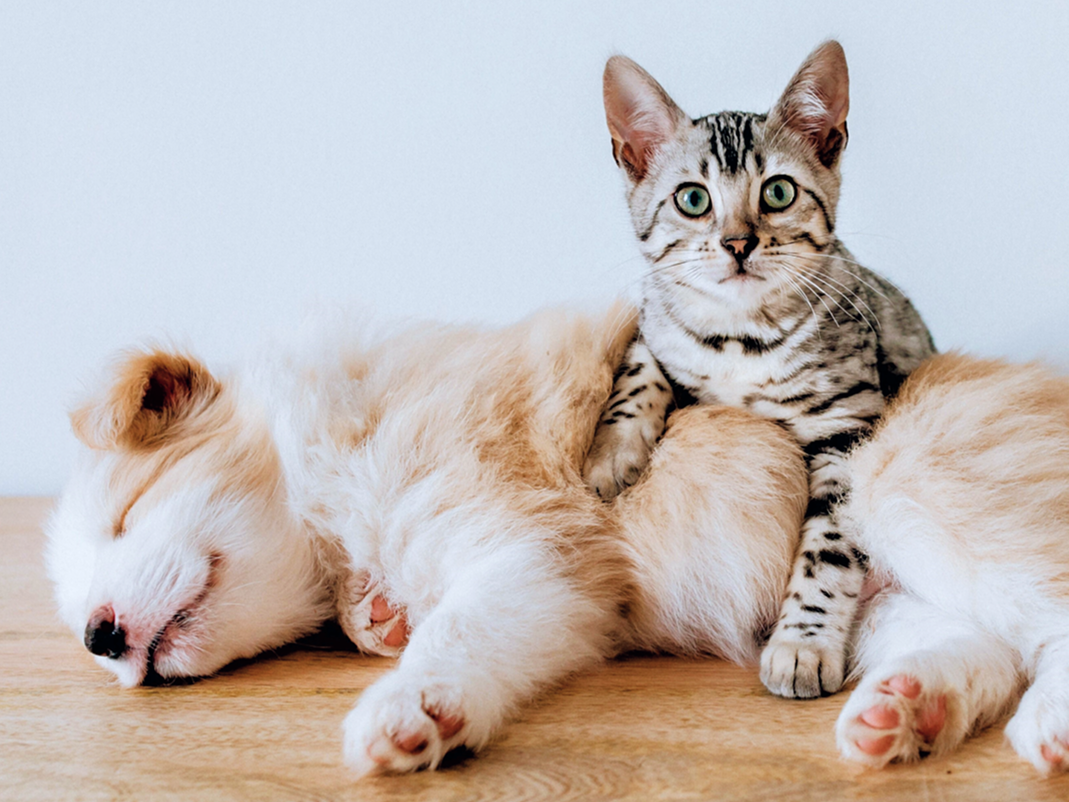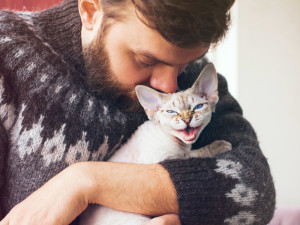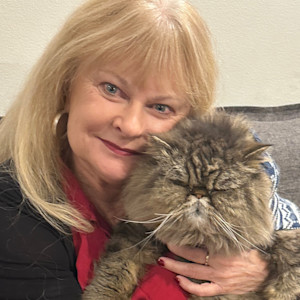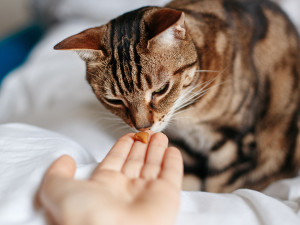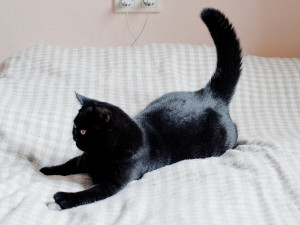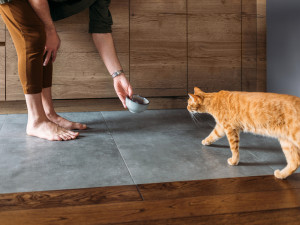What to Know About Hyperthyroidism in Cats
Everything you need to know about the common disease.
Your senior cat has a ravenous appetite but is getting thinner every day. Vomiting has increased to include more than just hairballs, and they’re peeing a lot. They used to be lazy and sleepy, but now they seem to be bouncing off the walls. Sound familiar? These are the classic symptoms of hyperthyroidism in cats, and they mean it’s time to get your cat to the vet.
Check out customizable policies from our friends at Lemonade Pet Insurance—so you only pay for what you need.
What is feline hyperthyroidism?
Feline hyperthyroidism is a common endocrine disorder in older cats. It is caused by an overproduction of thyroid hormones (primarily T3 and T4) from the thyroid glands. The condition usually results from a non-cancerous enlargement of one or both thyroid glands.
What does the thyroid do?
The thyroid gland regulates your cat’s metabolism, or how the body uses energy. The hormones it produces control the speed at which cells function. It also affects heart rate and cardiac output and has other essential responsibilities, including:
How much do you spend on your pet per year?
Helping control body temperature
Affecting brain and nervous system function
Supporting digestion and gut motility
Impacting skin and coat health
Simply put, your cat’s thyroid glands keep your kitty’s body running at the right pace. If it’s overactive (as in hyperthyroidism), everything speeds up. If it’s underactive (hypothyroidism, which is rare in cats), everything slows down.
Prevalence of hyperthyroidism in cats
Feline hyperthyroidism is the most common endocrine disease in older cats, especially those over 10 years old. It’s relatively common for a cat to develop hyperthyroidism; in fact, hyperthyroidism in felines has been increasing in incidence since the late 1970s, but the cause of that increase is unknown. It is estimated that 10 to 15 percent of cats over age 10 will be diagnosed with the condition, and no particular breed is more likely to become affected.
Causes and risk factors for feline hyperthyroidism
The cause of feline hyperthyroidism is excess hormones, T3 and T4, which are produced by a non-cancerous enlargement of one or more of the thyroid glands. The cause of that enlargement is unknown but may be related to deficiencies or excesses of certain compounds in a cat’s diet and possibly exposure to chemicals in the food or environment.
Symptoms of hyperthyroidism in cats
Cats with hyperthyroidism often have subtle signs at the beginning of their disease but can develop severe symptoms as the condition progresses. Symptoms include:
Weight loss
Increased appetite
Increased thirst
Increased urination
Vomiting
Diarrhea
Increased vocalization
Hyperactivity
High blood pressure
Heart disease
Kidney disease, which may develop as hyperthyroidism is treated
How hyperthyroidism is diagnosed in cats
Other chronic conditions, such as diabetes mellitus, kidney disease, cancer, and some intestinal diseases can share symptoms with hyperthyroidism. Your veterinarian can diagnose hyperthyroidism using a combination of your pet’s history, a thorough physical exam, and blood work. If your cat is displaying symptoms of hyperthyroid disease at home, your veterinarian will check for enlarged thyroid glands while performing a physical exam. A diagnosis is confirmed by measuring T4 levels in the blood. Occasionally, other blood tests are needed.
Additional blood work is used to look for common secondary issues, such as kidney or liver enzyme elevations. Screening for urinary tract infections, high blood pressure, and heart disease is helpful to determine if additional medications are needed in the short or long term.
Treatments for feline hyperthyroidism
Fortunately, there are multiple ways to approach the treatment of feline hyperthyroidism. There are four common forms of treatment, all of which aim to reduce the production of thyroid hormone, and there are pros and cons associated with each type.
1. Medications
Medications, such as methimazole, work by blocking the production of thyroid hormone.
Pros: Available in oral and topical formulations. Topical medication eliminates the need to wrestle cats to give them pills they don’t want to take. Medical management also has less up-front costs.
Cons: Lifelong daily medication is needed for disease management. Methimazole can cause vomiting or bone marrow suppression in some cats.
2. Surgery
Surgical removal of the thyroid glands is a permanent solution for feline hyperthyroid disease.
Pros: Surgery is a curative, one-time treatment (though, if the second gland enlarges in the future, a second surgery may be needed.)
Cons: Surgery is a costly anesthetic procedure, and anesthesia carries increased risk in older cats. There is also the risk of damaging the parathyroid glands, which are near the thyroid glands and help regulate blood calcium levels. There is also the possibility of the kidneys not functioning well after the thyroid gland(s) are removed, and there is no way to reverse the surgery.
3. Diet
Iodine is required for thyroid hormone production. A prescription diet for treating hyperthyroid disease has very low levels of iodine, so thyroid hormone production is limited.
Pros: A prescription diet has less upfront cost but can be expensive over a lifetime. Diet is a low-stress option for cats who will not tolerate medication.
Cons: Your cat must be exclusively fed a prescription diet (no more snacks or treats). You’re out of luck if your cat doesn’t like the food. Additionally, dietary restriction of iodine is somewhat controversial because of concerns about the effects of long-term iodine restriction on overall health and the possibility that such a diet may actually backfire and worsen hyperthyroidism. Research into this potential treatment option is ongoing.
4. Radioactive Iodine
In this treatment, your cat is given an injection of radioactive iodine. This will not give your kitty any superpowers, except for the ability to properly regulate their metabolism. The iodine will be absorbed by the thyroid glands, causing them to shrink and lose function.
Pros: Radiation is a curative treatment, meaning that long-term management of this disease is minimal.
Cons: Your cat must be hospitalized for several days after treatment until they’re a little less...radioactive. Really — veterinarians use dosimeters and everything. Extra precautions must be taken at home in the first couple of weeks after treatment to reduce human exposure to radiation. This can sound a little scary for some cat parents but may be the right answer for many cats with hyperthyroidism.
Long-term care for cats with hyperthyroidism
Medication will have to be given for the extent of the cat’s life. Surgery and radioactive iodine are meant to be a permanent fix. Low-iodine diets will have to be given forever to maintain a proper thyroid level.
Can you prevent hyperthyroidism in cats?
Although the cause of feline hyperthyroidism is unknown, possible contributing factors include deficiencies or excesses of certain compounds in the diet and chronic exposure to thyroid-disrupting chemicals in food or the environment. Until more research is done about the cause of hyperthyroidism in cats, we cannot prevent the disease.
Feline hyperthyroidism complications and related conditions
Complications that occur due to the systemic effects of excess thyroid hormones include:
1. Cardiomyopathy: Thickened heart muscle leading to tachycardia, gallop rhythms, arrhythmias, and congestive heart failure
2. High blood pressure: May lead to retinal detachment, blindness, and stroke-like signs
3. Masked chronic kidney disease: Hyperthyroidism can increase glomerular filtration rate, which can hide underlying kidney dysfunction. As the thyroid disease is treated, there will be a reduction in GFR which will unmask CKD. It’s extremely important to watch what happens to the kidneys as the thyroid is treated.
4. Muscle wasting and weakness
Related conditions, or conditions that often coexist with or can be mistaken for, hyperthyroidism, include:
1. Diabetes mellitusopens in new tab: Cats may show resistance to insulin if hyperthyroid
2. Inflammatory bowel disease (IBD) or GI lymphoma
3. Hepatic lipidosis or other liver dysfunction: Both thyroid disease and liver disease can show elevated liver enzymes.
4. Neoplasia: Thyroid carcinoma (rare cause of hyperthyroidism)
Prognosis for cats with hyperthyroidism
The prognosis for cats with hyperthyroidism can be excellent if the condition is caught early and treated properly. If the disease has not advanced to the point of affecting the heart, the kidneys remain healthy as the thyroid is treated, and the cat parent is strict about treatment, a cat with hyperthyroidism can live a normal life.
Bottom line
Hyperthyroidism is one of the top diseases affecting older cats. If you suspect your cat may have hyperthyroidism, it is important to see the vet right away. Blood tests and a physical exam can diagnose the condition. There are various ways to treat the disease. If diagnosed early and treated properly, your cat can live a normal lifespan.
FAQs
How long can a cat live with hyperthyroidism?
If a cat is otherwise healthy and is treated properly for thyroid disease and has regular rechecks, they can live a normal life.
What are the signs of hyperthyroidism in cats?
Signs of hyperthyroidism in cats include excessive thirst, urination, and appetite with weight loss plus increased vocalization, hyperactivity, vomiting, diarrhea, and hyperactivity.
How to help a 17-year-old cat with hyperthyroidism?
See the vet as soon as you suspect hyperthyroidism. If the results of tests and exam are positive, start treatment and have regular rechecks. At age 17, you will probably opt for medication for treatment because surgery and radioactive iodine may be too risky.
Why can't you touch methimazole?
You shouldn’t touch methimazole, especially the uncoated tablets or powder form, with bare hands because it can be absorbed through the skin, which may lead to an effect on your own thyroid level.
References
Cornell Feline Health Center. “Hyperthyroidism in Cats.” opens in new tabCornell University College of Veterinary Medicine, 11 Oct. 2017, Center.
“Hyperthyroidism in Cats—Two FDA-Approved Drugs Available to Treat It” opens in new tab U.S. Food and Drug Administration, 2024.
Mooney, Carmel T. “Feline Hyperthyroidism.”opens in new tab Veterinary Clinics of North America: Small Animal Practice, vol. 31, no. 5, Sept. 2001, pp. 963–983,.
